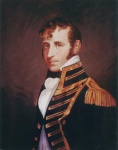-
 On This Day 25 September
On This Day 25 September
The Action of 25 September 1806 was a naval battle fought during the Napoleonic Wars off the French Biscay port of Rochefort. A French squadron comprising five frigates and two corvettes, sailing to the French West Indies with supplies and reinforcements, was intercepted by a British squadron of six ships of the line that was keeping a close blockade of the port as part of the Atlantic campaign of 1806. The British ships, under the command of Commodore Sir Samuel Hood, spotted the French convoy early in the morning of 25 September, just a few hours after the French had left port, and immediately gave chase. Although the French ships tried to escape, they were heavily laden with troops and stores, and the strong winds favoured the larger ships of the line, which caught the French convoy after a five hour pursuit, although they had become separated from one another during the chase.
At 05:00 the leading British ship, HMS Monarch, was within range and opened fire on the French squadron, which divided. One frigate went north and was intercepted by HMS Mars, while another, accompanied by the two corvettes, turned south and managed to outrun HMS Windsor Castle. The main body of the French force remained together and met the attack of Monarch and the British flagship HMS Centaur with their broadsides. Although outnumbered and outclassed by the British squadron the French ships fought hard, inflicting damage on the leading British ships and severely wounding Commodore Hood. Eventually the strength of the British squadron told, and despite a fierce resistance the French ships surrendered one by one, the British capturing four of the seven vessels in the squadron.
-

On 25 September 1801 a privateer hoisting the Spanish flag unsuccessfully engaged the schooner HMS Pickle in a single-ship action that resulted in the death of Pickle's commander, Lieutenant Greenshields, and the wounding of Midshipman Pierce, the master, Thomas Hayer, and seven others of her crew. At 11am, some five or six miles NW of the Isle of Ash (aka Île à Vache or Cow Island, south of Hispaniola), Pickle sighted a vessel flying the British flag and sailing towards it. When the vessel got within pistol-shot, she hauled up the Spanish flag and opened fire. The fight lasted an hour and a quarter, with a musket ball through the body killing Greenshields about 40 minutes in. The Spanish vessel then tried to board Pickle, but when the Spaniard was unable to do so, he fled. Pickle chased the privateer for an hour and a half but the privateer was faster and Pickle gave up the chase. Hayer, who wrote the report of the action, described the privateer as having two 12-pounder and two 9-pounder guns, and a crew of about 70 men. Pickle had a crew of 35, of whom three were incapacitated by illness, and was armed with 8 12-pounder carronades.
-

On 25 September 1805, the 56-gun HMS Calcutta, under the command of Captain Daniel Woodriff, was escorting a convoy in the Channel south of the Isles of Scilly when lookouts spotted a number of unknown vessels in the distance. Calcutta moved to position herself between the convoy and the unknown flotilla.
Next morning it became clear that the unknown vessels were probably French so Calcutta signaled the convoy to make sail without her and moved to intercept the French vessels. She sailed towards the nearest vessel, which turned out to be the 40-gun frigate Armide. The engagement was desultory but Calcutta succeeded in luring the French southward and away from the convoy. As a result, the French detached the brig Sylph which captured only the slow-sailing Brothers.
However, eventually the rest of the French squadron started to arrive. It turned out this was Contre-Admiral Zacharie Allemand's squadron, which included the 74-gun Magnanime. Woodriff brought Calcutta alongside Magnanime, but after a battle of some three-quarters of an hour was forced to strike. The French had shot high, bringing down Calcutta's rigging, disabling her. Because they fired high, Calcutta suffered only six dead and six wounded out of a crew of 350. The French brought Calcutta into French service.
Woodriff was imprisoned at Verdun and appealed to Talleyrand for release, without success until in early 1807 the French sent him to Saint Malo. There the French government provided him a vessel under cartel (ship)\cartel to take him to England. The British government immediately reciprocated by releasing a French officer of equal rank. The court-martial on Gladiator, on 1 January 1808, for Woodriff and his officers acquitted all, praising the captain for his gallantry and skillful maneuvering, which had allowed the convoy to escape.
 Posting Permissions
Posting Permissions
- You may not post new threads
- You may not post replies
- You may not post attachments
- You may not edit your posts
-
Forum Rules






 Reply With Quote
Reply With Quote
Bookmarks